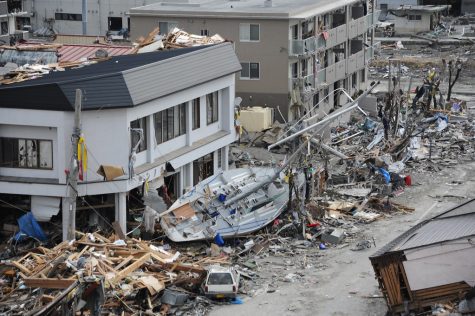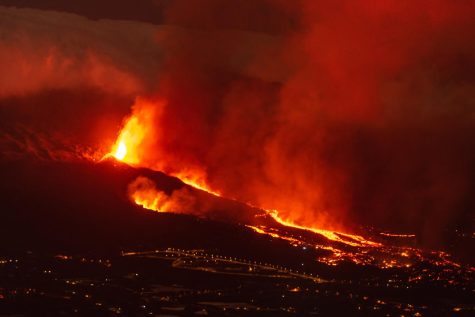Impact of Natural Disasters
Japanese Tsunami 2011
November 22, 2021
Natural Disasters are natural events that cause extreme discomfort and fear. These disasters usually result in multiple injuries and even death. However, do we actually understand the magnitude and impact that natural disasters cause for people?
Living in New Jersey, we do not experience a lot of natural disasters. A majority of the time, we are not fearing our house being crushed by boulders, or getting buried in ash. In New Jersey, we do have flooding and the occasional hurricane or tornado, but we are typically not always afraid. This cannot be said about other parts of the world.
A country that has been hit by so many natural disasters, that it is almost normal for the people there, is Japan. Japan is an island country off the coast of eastern Asia that is known for having lots of advanced technology and clean cities. However, Japan has a darker side. You see, Japan is located in the Ring of Fire, an area of land that has many volcanoes. Because the Ring of Fire and all volcanoes are formed by tectonic plates and fault lines, Japan, along with it having 110 active volcanoes, is also located extremely close to a very active fault line. This results in a huge number of earthquakes. In Japan, when smaller earthquakes strike, people continue on with their lives like it’s not an issue. The extreme number of lower magnitude earthquakes has caused Japanese people to adapt to not being afraid of earthquakes of lower magnitudes. However, every now and then, there is a very big earthquake, causing many large disasters in Japan.
In March of 2011, Japan experienced a magnitude 9.1 earthquake, which’s epicenter

was off the coast near the city of Sendai. The earthquake caused a gigantic tsunami that flooded the eastern coastline of Honshu (Japan’s biggest island), and is known as the “costliest natural disaster in world history,” with a total damage of $360,000,000,000 (360 Billion USD). It also killed almost 20,000 people, and injured many more. The photo to the right, taken by the U.S Pacific Fleet, shows a fishing boat that was dragged inland onto a street.
Our next country is the country of Haiti in the Caribbean, which is a hotspot for natural disasters. Ninety-six percent of Haiti’s population is exposed to natural disasters, including constant hurricanes, flooding, and earthquakes. Haiti is located on the faultline between the North American and Caribbean plates, and in most cases, being on a fault line results in earthquakes. Also, because of its unfortunate location, it is exactly where hurricanes typically pass through, due to the nice warm water in the area forming them.

14/Jan/2010. Port-au-Prince, Haiti. UN Photo/Logan Abassi. www.un.org/av/photo/ (UN Photo/Logan Abassi)
The most recent notable natural disaster was the August earthquake of this year. This earthquake affected Haiti’s Tiburon Peninsula most severely. It was a magnitude 7.2, causing at least 2,248 deaths. The earthquake caused $1 billion USD in damage, which sounds like a lot, but isn’t compared to a lot of other disasters in Haiti’s history. In 2010, a magnitude 7 earthquake hit 25 kilometers (15.5 miles) west of Port-au-Prince, Haiti’s capital. This earthquake caused an estimated damage cost between $7.8 billion – 8.5 billion USD, and killed more than 200,000 people. The photo above was taken by United Nations Photo, and shows a street in downtown Port-au-Prince. As you can see, it is, for the most part, destroyed. This earthquake was so bad because it was very close to the surface, while most are deeper. This caused it to make the earth shake more than it normally would. Constant natural disasters make living in Haiti extremely difficult.

Now, we move onto our final location. La Palma, an island that is part of Spain’s Canary Islands, has a volcano erupting that has been for over a month. Cumbre Vieja is an active volcano ridge that has been erupting since September 19th, 2021. At the time of writing this article, it is November 11th, 2021. Even though the cone collapsed in October, the volcano still hasn’t stopped. It has forced over 6000 people to evacuate their homes and communities. The photo to the right was taken by Spanish journalist, Eduardo Robaina, and shows what Cumbre Vieja looked like on September 20th, one day after the eruption started. There is lava covering large portions of the land near the volcano. Entire neighborhoods on La Palma are being completely covered with flowing lava and ash at this time.
Earth brings us, obviously, a lot of good things. However, it also brings a lot of bad things that could ruin lives. Natural disasters are obviously one of the bad ones. Hopefully this article has helped you understand the difficulties and uncertainty of living in an area with a lot of natural disasters.









